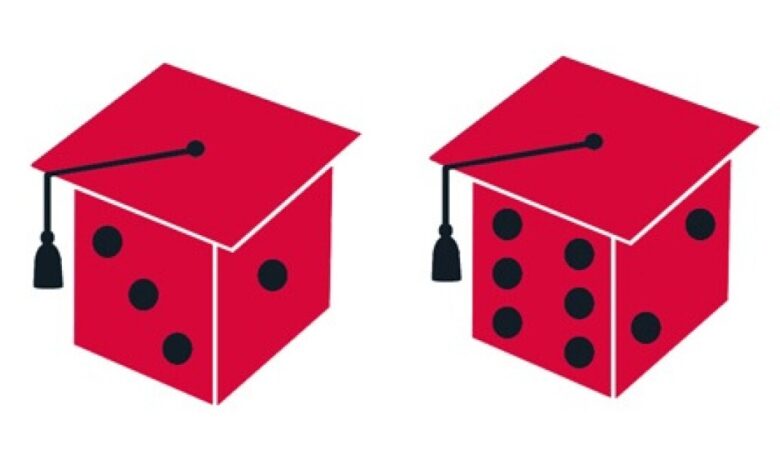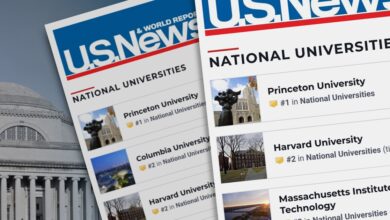Admissions as a Game of Chance? New Research Says Lotteries Could Decrease Diversity

The college-admissions process leads to many inequitable outcomes, but turning it into a giant game of chance might make things worse.
That’s according to a new study of the feasibility of admissions lotteries published on Wednesday in Educational Researcher, a peer-reviewed journal of the American Educational Research Association. Selective institutions, two prominent researchers found, could see a sharp decrease in the enrollment of low-income and minority students — and men — if they were to admit students via a vast random drawing.
The findings complicate a widely held notion that lotteries could make the admissions process more equitable, an idea that proponents have been kicking around for more than 40 years, at least. Though the proposals have varied, the gist is the same: Colleges would set minimum eligibility thresholds, perhaps adding weights for some variables, and then, just like in bingo — B5! G18! — chance would determine the final outcomes.
“A lot of people like the idea of a lottery because it seems like the most fair thing,” said Dominique J. Baker, an assistant professor of education policy at Southern Methodist University and a co-author of the study. “But that doesn’t mean it would be an equitable fix. Statistically fair is not automatically equitable or just. With a random admitted class,” she said, “there’s no guarantee in a single year that the demographic makeup, in terms of race, gender, and income, will look the same as what it is in the eligible lottery population.”
Baker and her co-author, Michael N. Bastedo, a professor of education at the University of Michigan at Ann Arbor, conducted robust simulations of admissions lotteries for their study, the first to analyze the potential effects of multiple criteria for lottery eligibility, including high-school grade-point-averages and SAT/ACT scores with varying minimum thresholds, used both together and separately. The researchers drew from nationally representative federal data sets to compare the characteristics of students enrolled at highly selective (Ivy League, etc.) and moderately selective colleges (such as the University of Georgia) with those of students who could have enrolled based on a national lottery.
They found “dramatic and negative potential effects” of lotteries on student diversity. In the vast majority of simulations, the proportion of low-income students and students of color plummeted, in some models to below 2 percent of the class. GPA-only and SAT-only lotteries did not result in a pool of students with a greater share of low-income admits.
The most consistent finding for GPA-eligibility lotteries was that the pool of eligible students included a significantly smaller share of men. Those results were consistent across a range of minimum-GPA thresholds, weighted GPAs, and standardized-test scores.
In simulations using mixed-eligibility criteria — SAT and weighted GPA — the eligible pool of Black and Hispanic students was the lowest — and did not equal the share of those students currently enrolled at selective colleges.
“Admissions lotteries, with minimum bars for GPA and/or standardized tests,” the researchers wrote, “do not appear to produce more-equitable outcomes.”
In short, applicants in some subgroups would be much more likely to get a lottery ticket than others. “For any measure of academic ability required to gain access to the lottery,” Baker said, “we have to keep in mind that whatever inequities there are for those measures would be baked into the lottery itself.”
Another crucial point: Lottery results would be volatile. And colleges crave predictability in their pursuit of enrollment goals for diversity and revenue, while filling specific majors and ensuring there are enough goalies for each team. “There would be a lot of variation from year to year,” Baker said. “I don’t know how you tell an institution that, if they do a lottery, one year 2 percent of their students could be Black, then the next year it could be 10 percent.”
The only way to ensure racial and ethnic diversity would be to run a lottery within each subgroup of students. But such a plan, the researchers note, would surely run afoul of the U.S. Supreme Court’s ban on the use of racial quotas in admissions.
Baker said she and Bastedo did not set out to bash admissions lotteries, which some well-informed researchers have described as a desirable way to curb inequitable admissions practices, easing applicants’ anxiety, and minimizing debates over race-conscious admissions. It’s understandable why a lottery might seem like an appealing alternative to a status quo that favors white, affluent students and often delivers results that might seem unfair to any disappointed applicant.
If nothing else, such a system would be relatively simple — and not so opaque. “It’s incredibly transparent, and some people latch on to that part,” Baker said. “But they don’t deal with the actual implementation and ask, ‘What does this look like in reality?’”
In reality, it looks impractical, requiring cooperation among colleges that probably would put them at risk of violating federal antitrust laws. Moreover, it would in many ways prevent admissions officers from using their judgment when evaluating applicants’ achievements — and the context of those achievements — in holistic evaluations.
Baker, a former admissions officer, described the current system as far from perfect. “But there are positive things that come from that system,” she said. “Institutions are able to make certain decisions in ways that serve racial equity.”
Decisions that they wouldn’t want to leave to chance.
Source link






